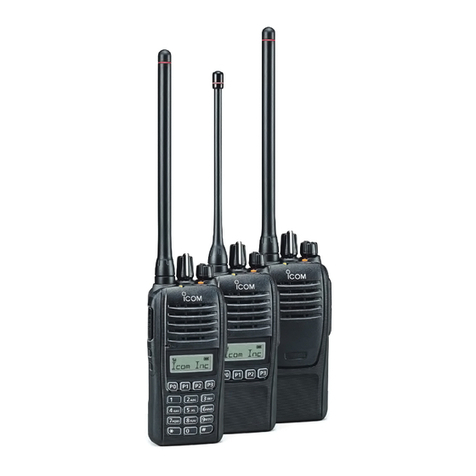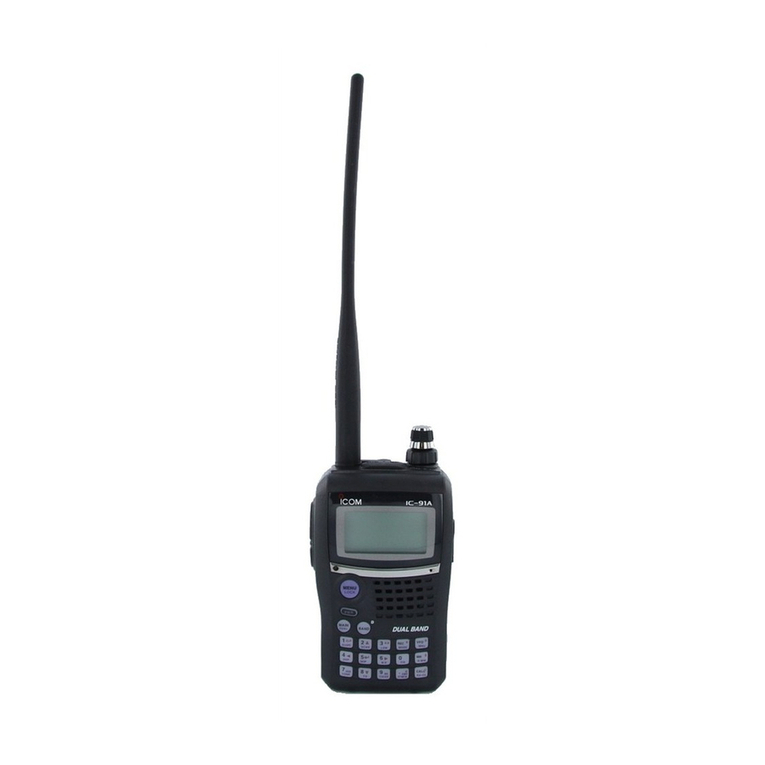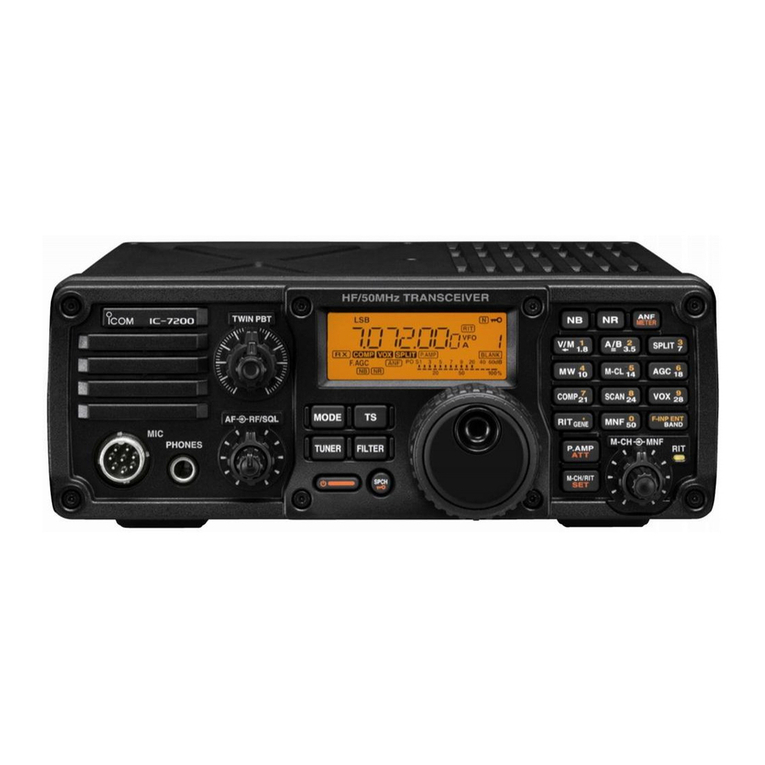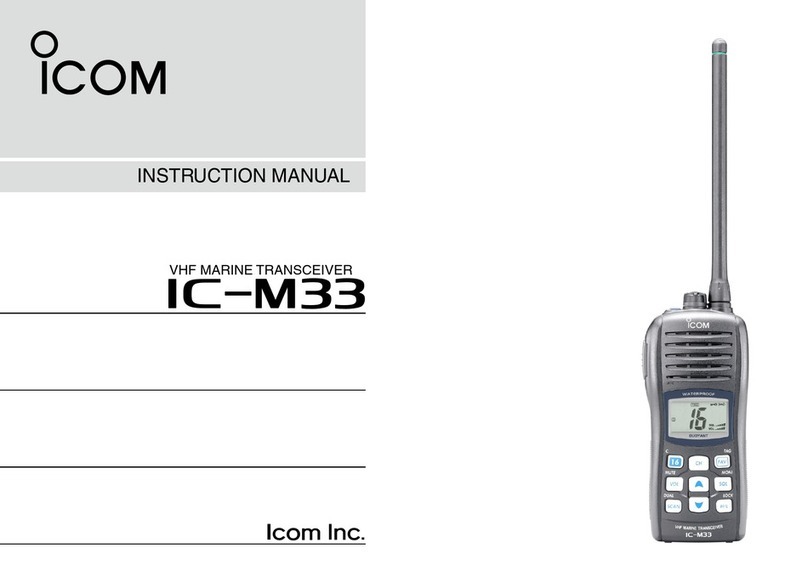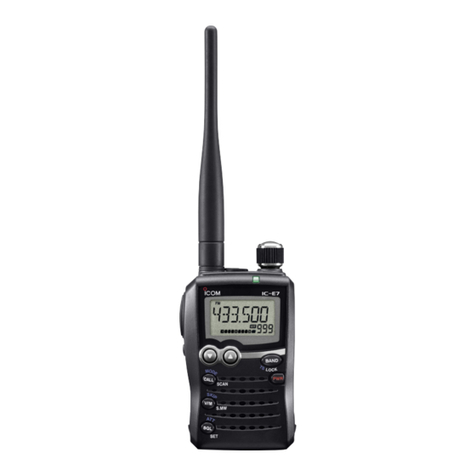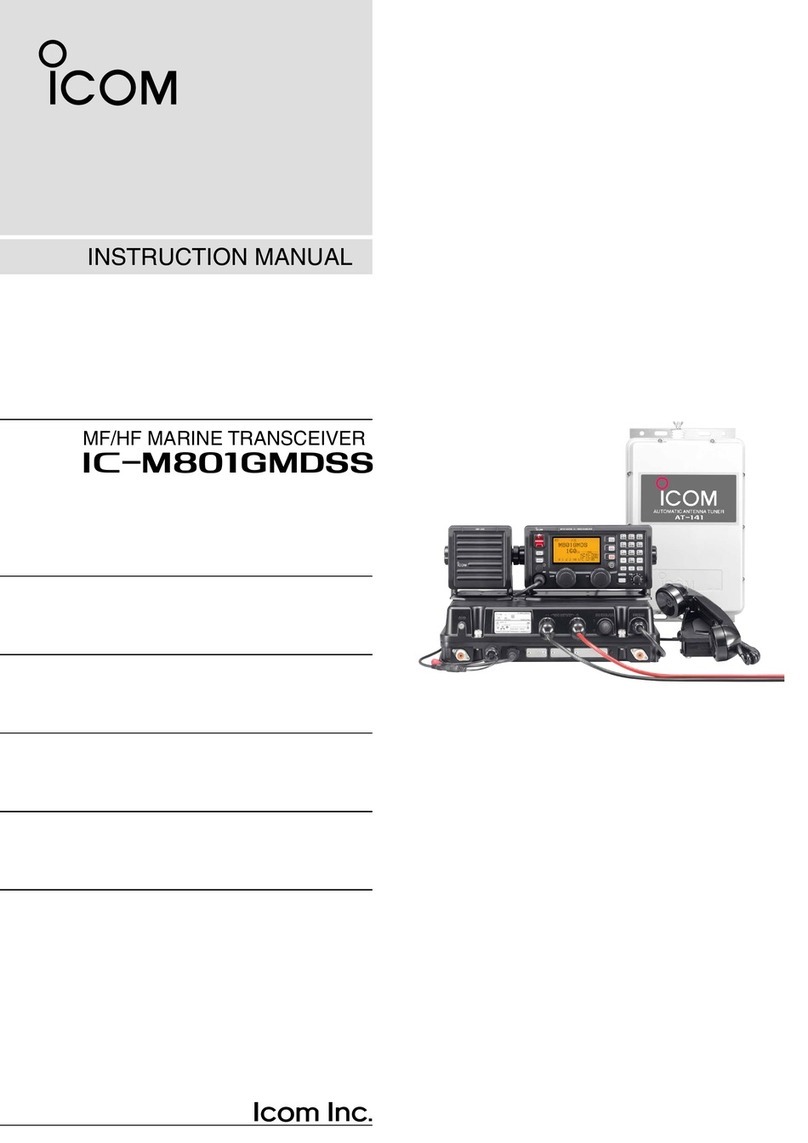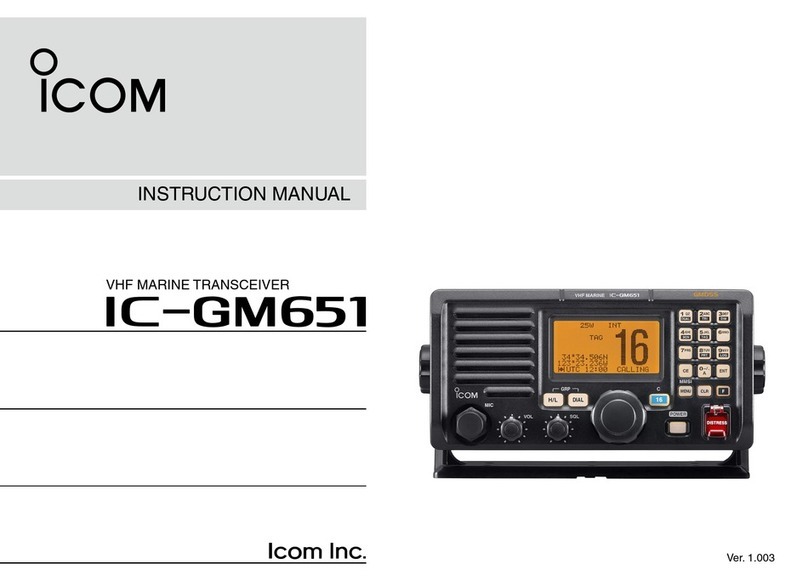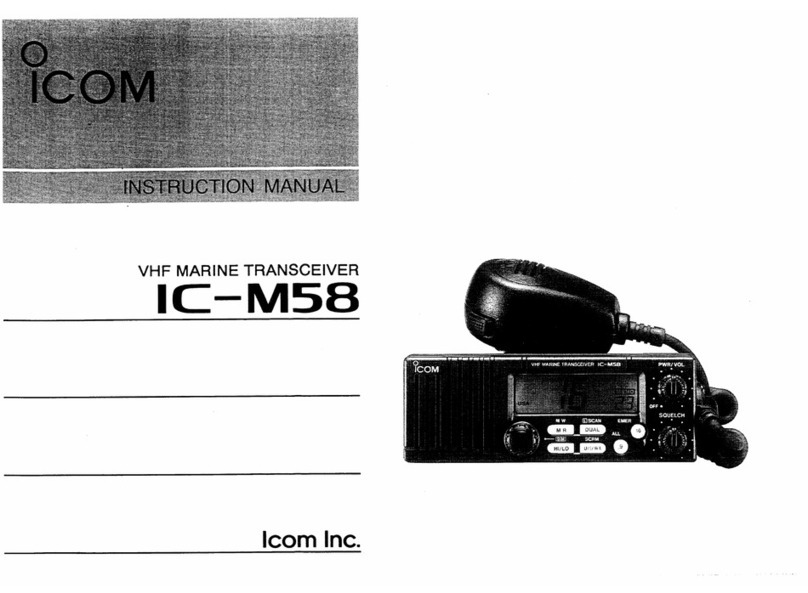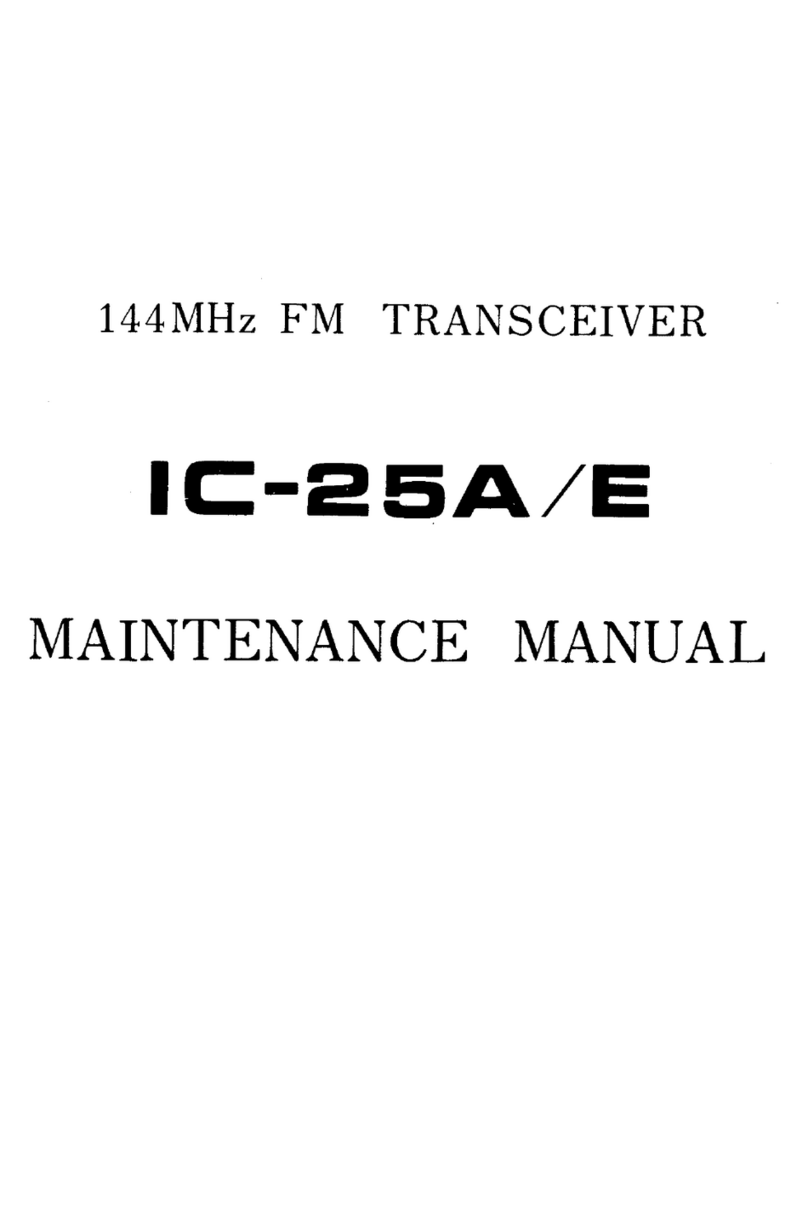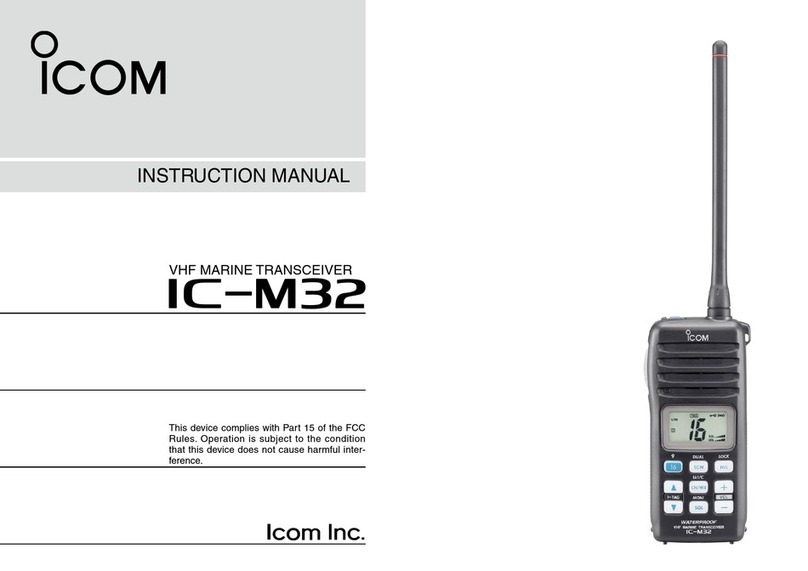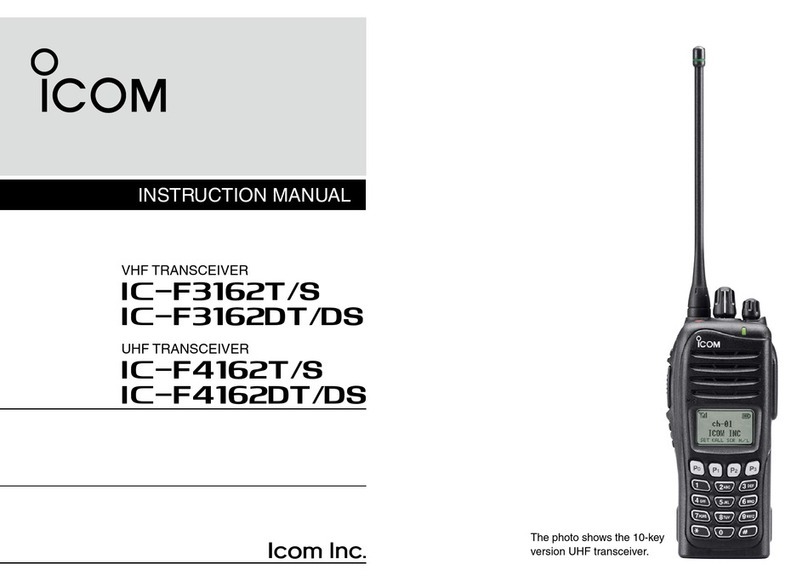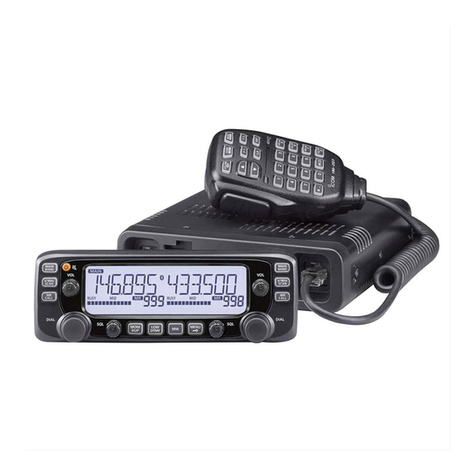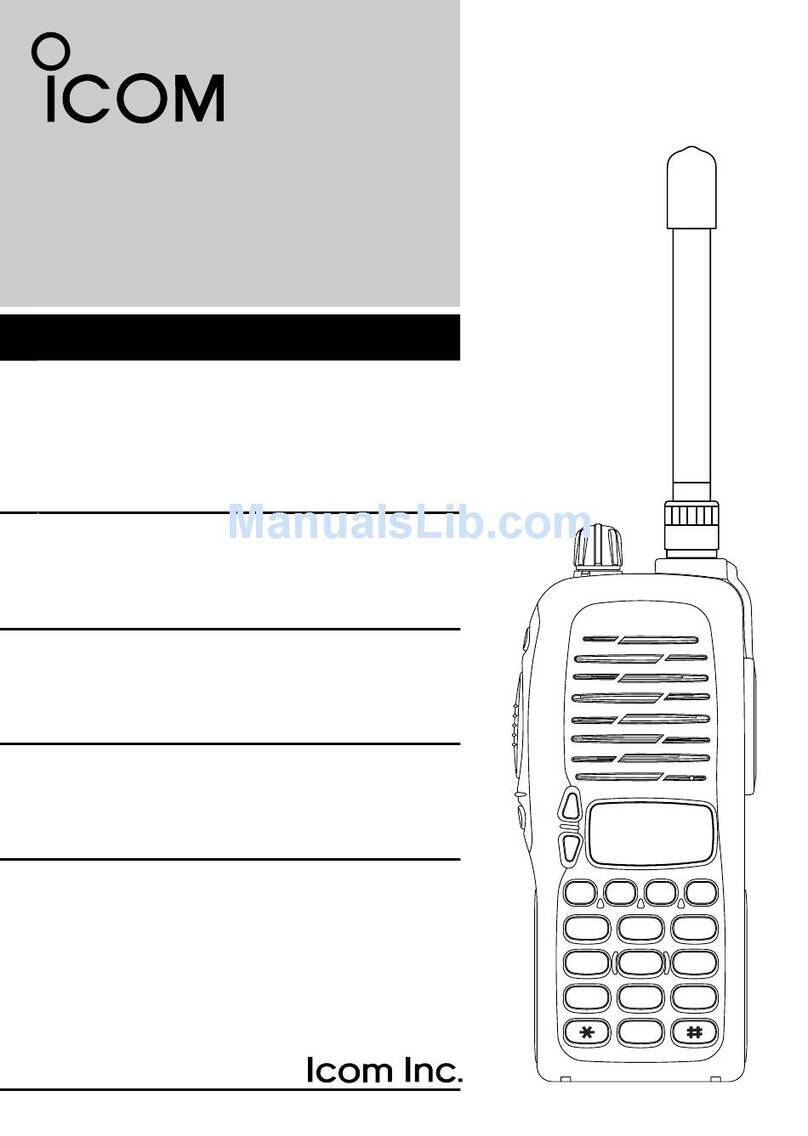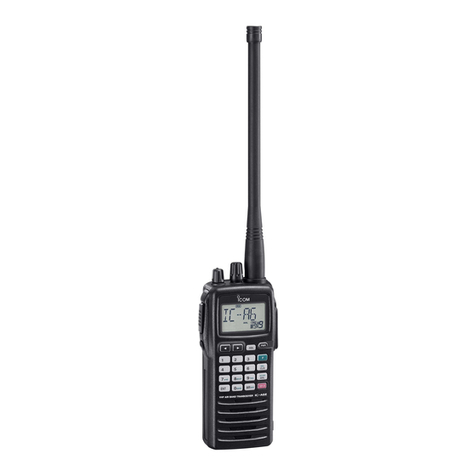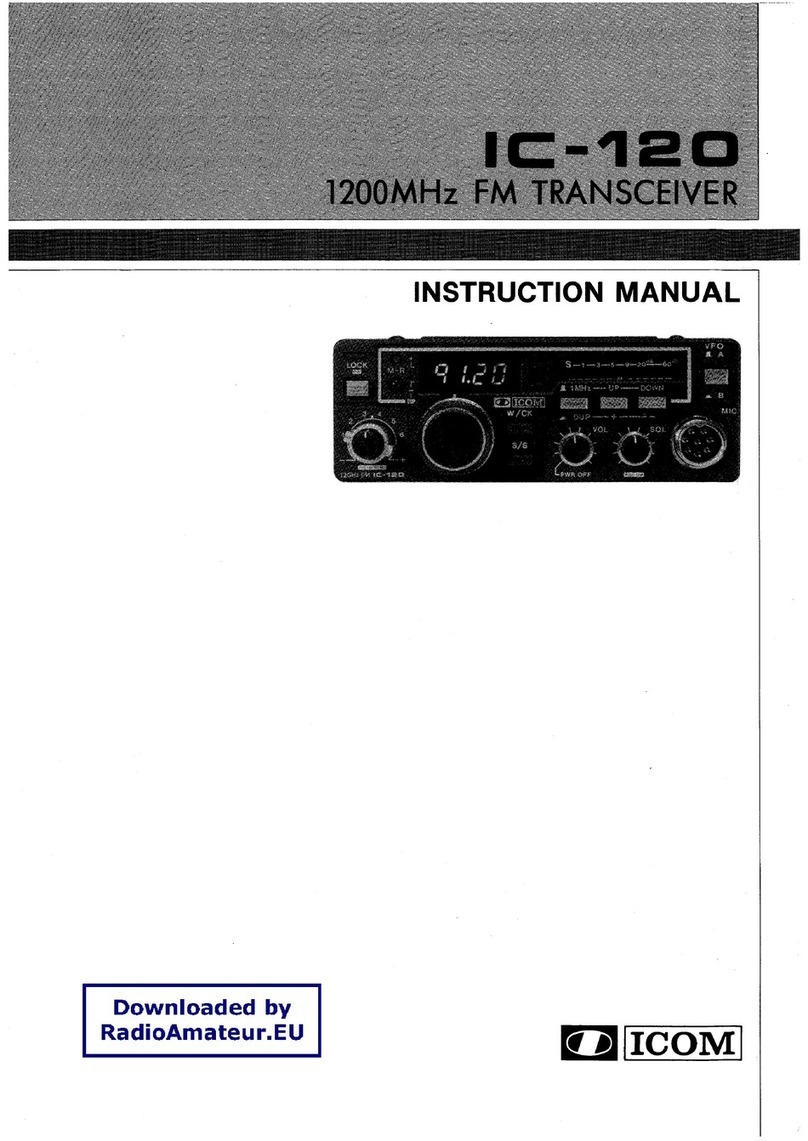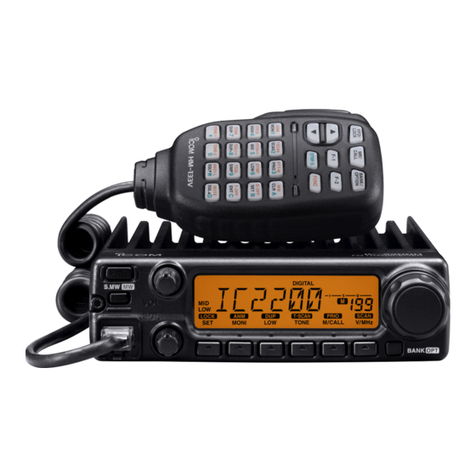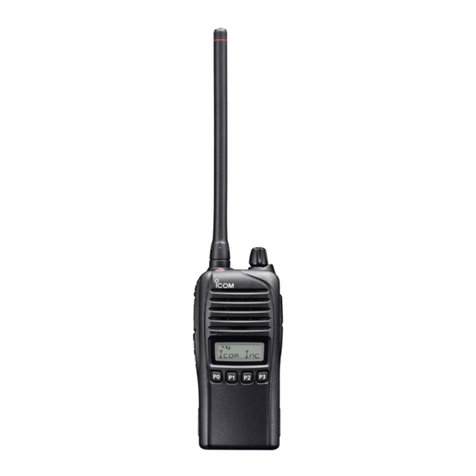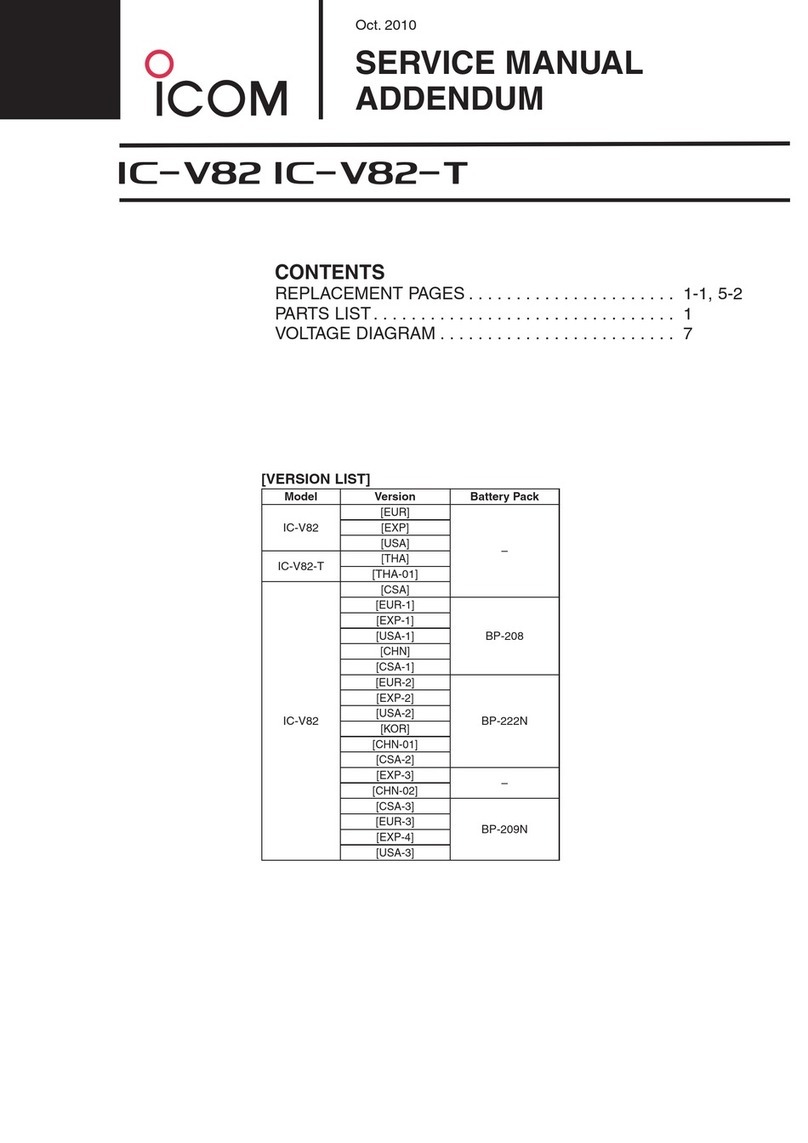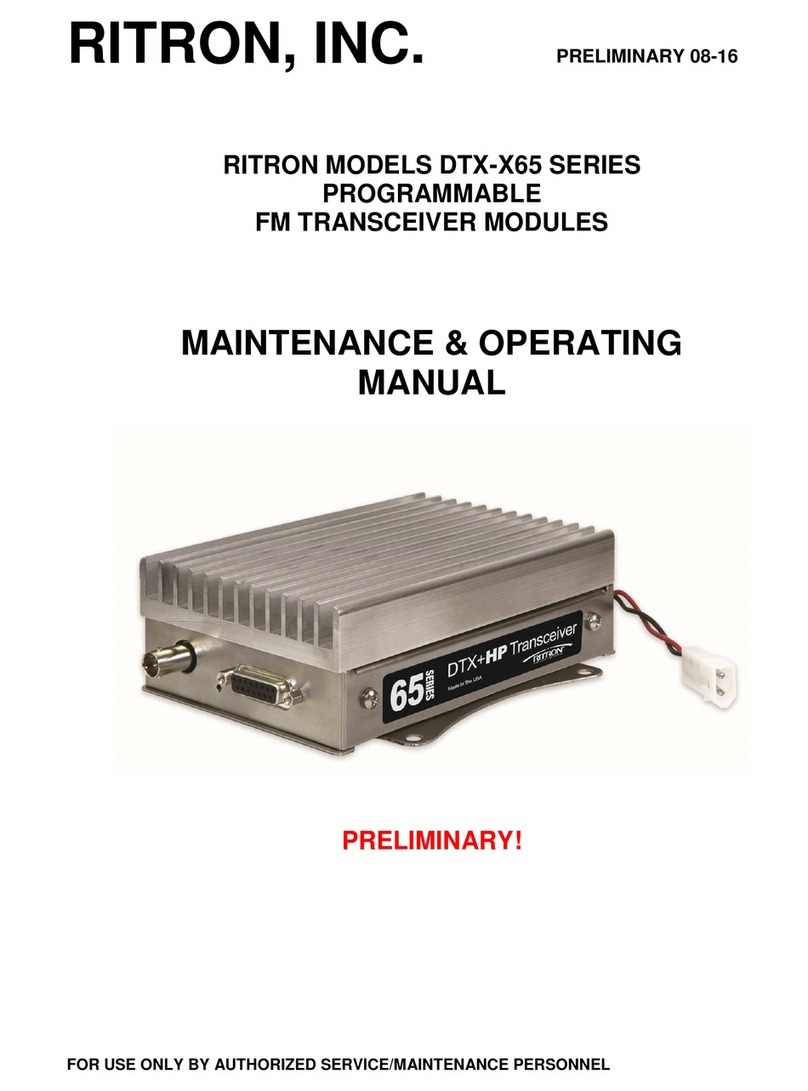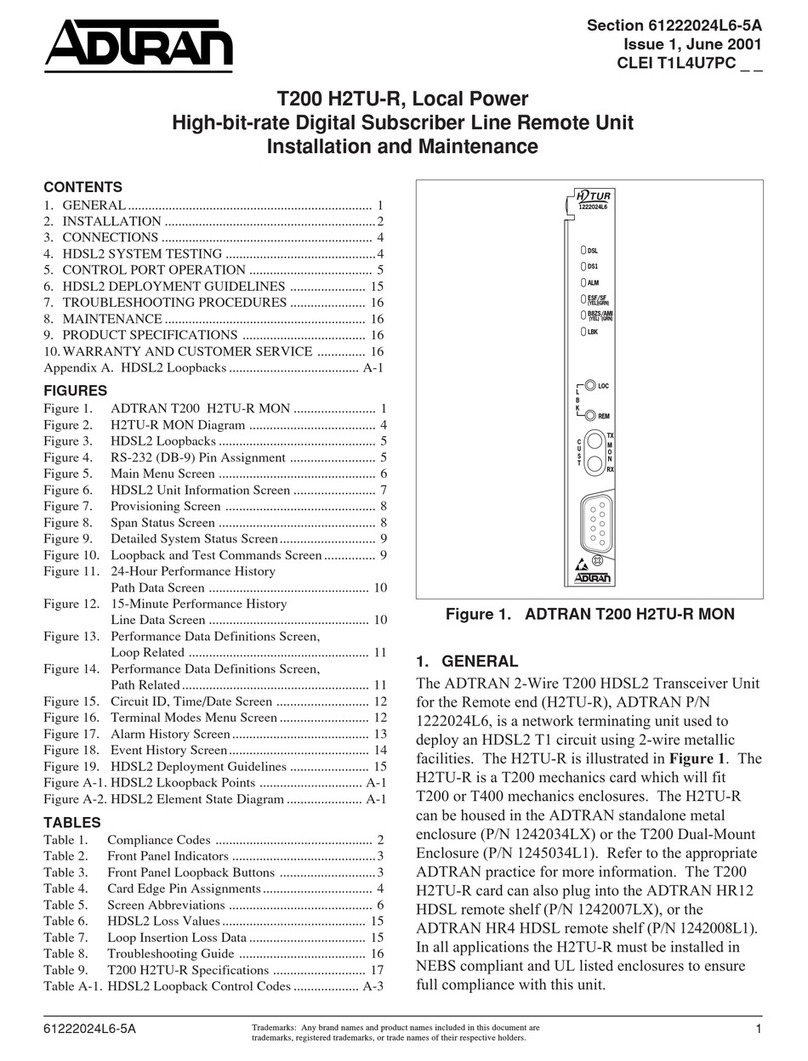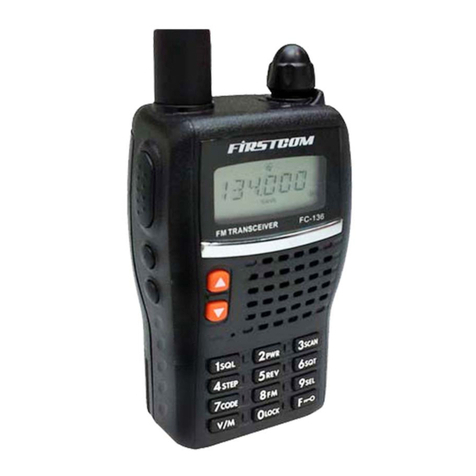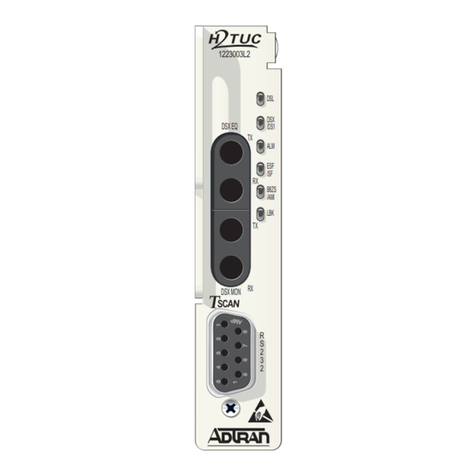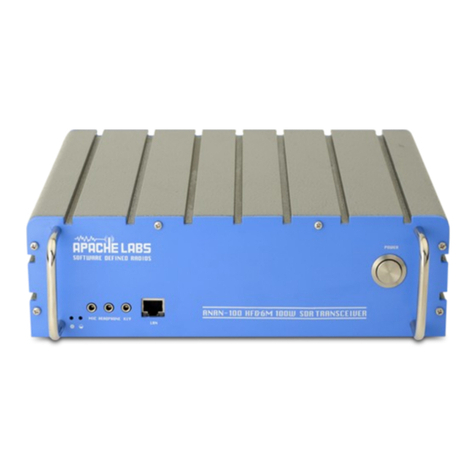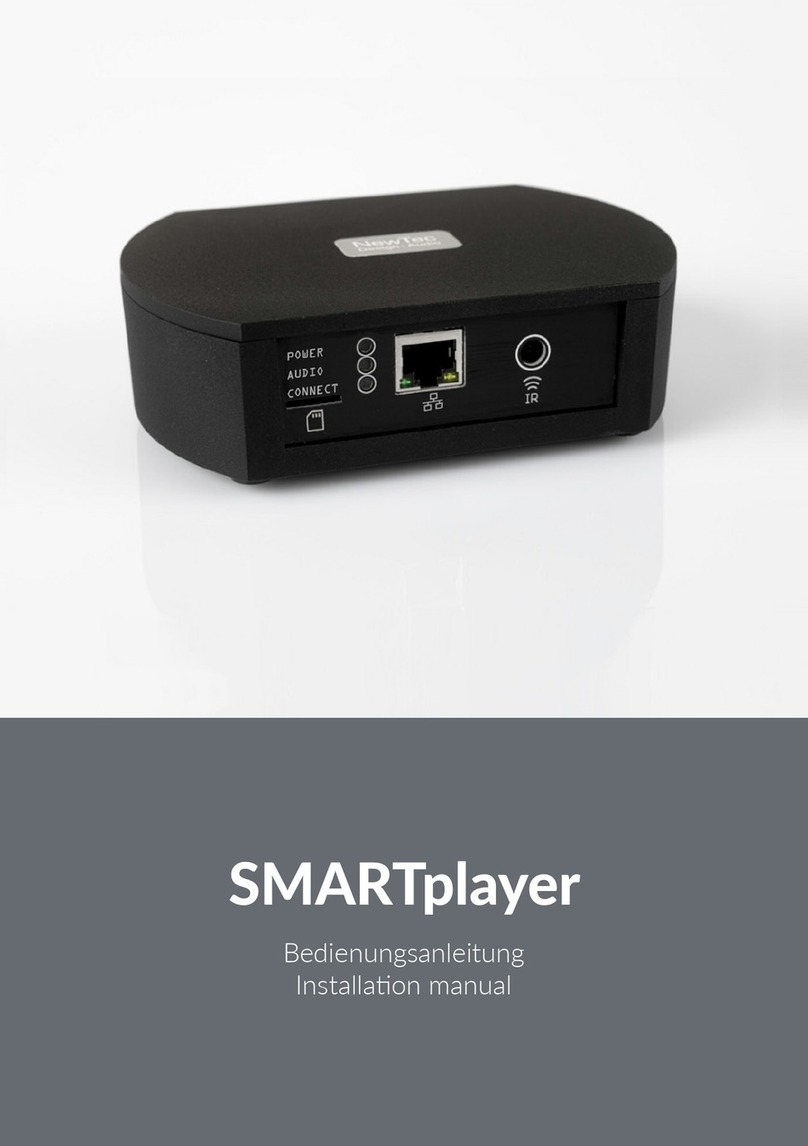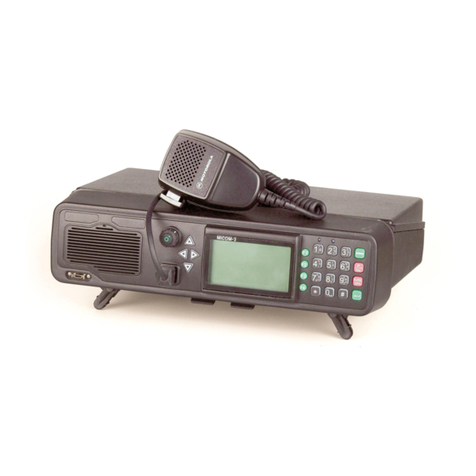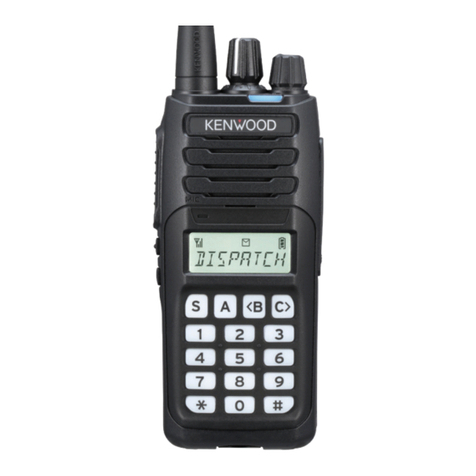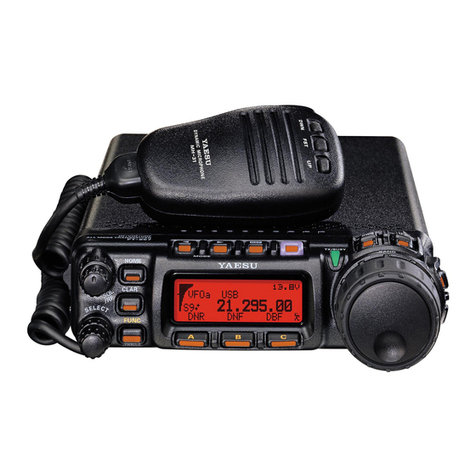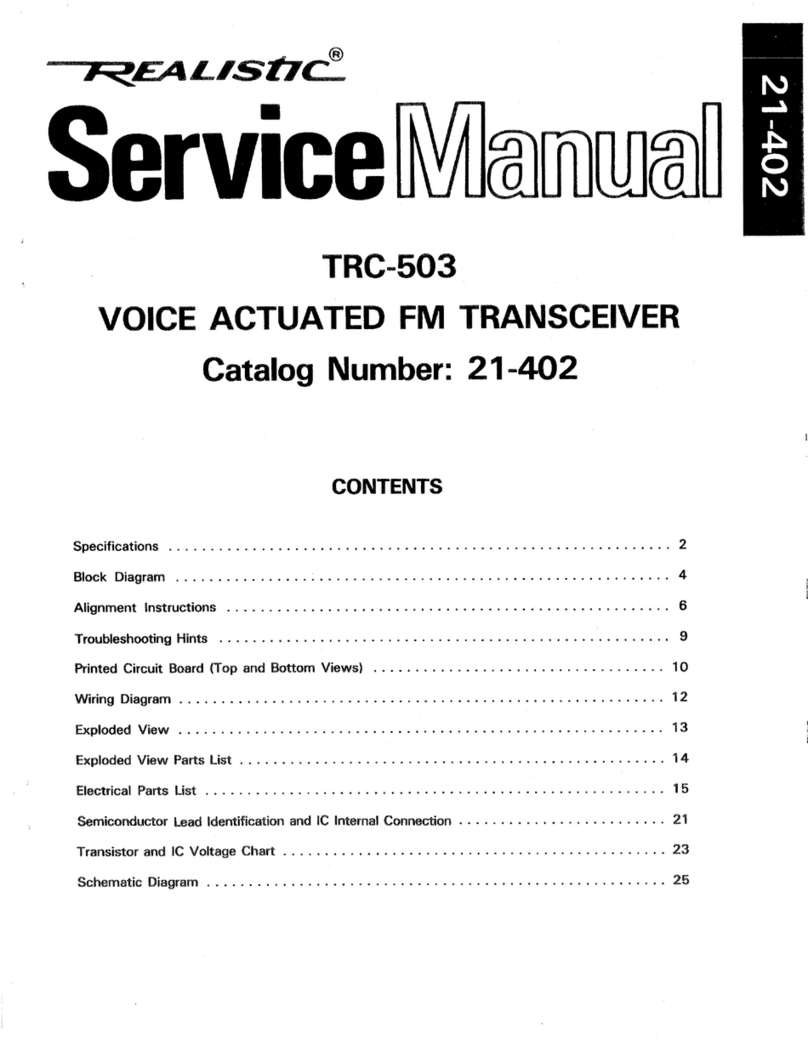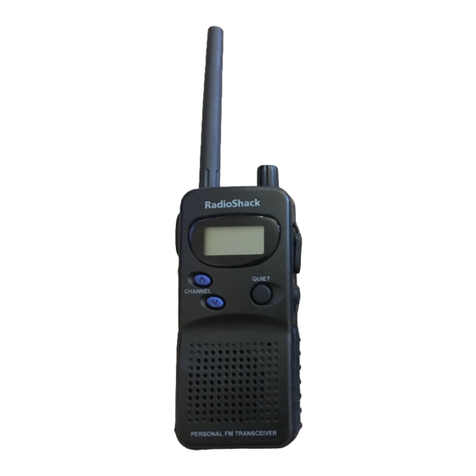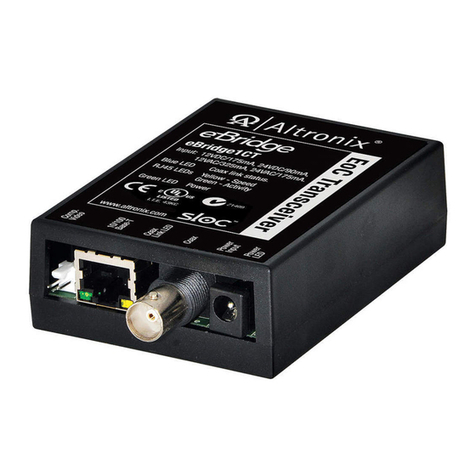Icom IC-V10MR User manual

OPERATING GUIDE
VHF TRANSCEIVER
IC-V10MR

i
We appreciate you choosing Icom for your communication
needs.
The MDC 1200 signaling system is built into your
IC-V10MR transceiver.
READ ALL INSTRUCTIONS carefully and completely
before using the transceiver.
SAVE THIS OPERATING GUIDE — This operating
guide contains important operating instructions for:
•IC-V10MR TRANSCEIVER
Icom, Icom Inc. and the Icom logo are registered trademarks of Icom Incor-
porated (Japan) in Japan, the United States, the United Kingdom, Germany,
France, Spain, Russia and/or other countries.
All other products or brands are registered trademarks or trademarks of their
respective holders.
IMPORTANT

TABLE OF CONTENTS
ii
IMPORTANT.......................................................................... i
TABLE OF CONTENTS........................................................ ii
1 PANEL DESCRIPTION................................................1–5
■Front, top and side panels............................................1
■
LED indicator................................................................3
■Programmable function keys ........................................4
2 BASIC OPERATION...................................................6-13
■Channel selection.........................................................6
■Receiving and transmitting...........................................6
■Emergency Call............................................................8
■Lone Worker Emergency Call.......................................9
■Man Down Emergency Call..........................................9
■Motion Detection Emergency Call................................9
■User set mode............................................................10
■Setting the microphone gain ......................................10
■Setting the squelch level ............................................11
■Setting the Beep function and level............................12
■Setting the Ringer level ..............................................13
3 MDC 1200 SYSTEM OPERATION..........................14–15
■MDC 1200 system operation......................................14
■Receiving a call ..........................................................14
■Transmitting a call.......................................................15

■Front, top and side panels
q ROTARY SELECTOR
Rotate to select the preset memory channels.➥
w VOLUME CONTROL [VOL]
Rotate to turn the power ON or OFF and to adjust the➥
audio level.
eDEALER-ASSIGNABLE KEY [Emer]
A desired function can be programmed by your dealer.➥
1
1PANEL DESCRIPTION
w VOLUME
CONTROL [VOL]
e [Emer]
Speaker
r SPEAKER-
MICROPHONE
JACK
Microphone
t
yPTT
iANTENNA
SWITCH
[PTT]
LED
INDICATOR
CONNECTOR
[Upper]
[Lower]
q ROTARY
SELECTOR
t
u

2
1
PANEL DESCRIPTION
1
2
3
4
5
6
7
8
9
10
11
12
13
14
15
16
rSPEAKER-MICROPHONE JACK
Connect optional equipment.➥
NOTE: After turning OFF the transceiver, connect or dis-
connect the optional equipment.
tDEALER-ASSIGNABLE KEYS
yPTT SWITCH [PTT]
u
[Upper], [Lower]
➥Desired functions can be independently programmed
by your dealer.
i ANTENNA CONNECTOR
Hold down to transmit, release to receive.➥
LED INDICATOR
Lights red while transmitting.➥
Lights green while receiving a signal, or when the➥
squelch is open.
➥Lights or blinks orange when the matched 2-Tone
is received, depending on the presetting.
➥You should charge the battery when the indicator slow-
ly blinks.
You must charge the battery when the indicator blinks➥
fast.
Connects the supplied antenna.➥
Jack cover
NOTE: Attach the jack cover when
optional equipment is not used.

3
1
PANEL DESCRIPTION
■LED indicator
The LED indicator indicates the status of various parameters of
the transceiver as follows:
(Reference: R=Red, G=Green, O=Orange)
G G
R O G R O G
OOOOOO
OOOO
OOOR
OG
OR
GROGROGROGRO
G G G G
G
• Receiving
• Low Battery 2 (You must charge the battery.)
• Low Battery 1 (You should charge the battery.)
• When turning ON the power
• Calling
• Audible
• Lockout, TX Inh, TOT (when transmit is inhibited)
• Successful
• Failed, Error
• Emergency, Siren
G GGGG GGG
R G R G R G R G R G R G R G R G
R O R O R O R O R O R O R O R O
R R R R
R R
R
O
OO
GG
• Cloning (reading or writing data)
• Cloning Error (if cloning fails)
• Inh, Blank CH, Unlocked (when you cannot use the channel)
• TX Low Battery 2 (while transmitting)
• TX Low Battery 1 (while transmitting)
• Transmitting
• Call LED=ON (when receiving a matched 2-Tone or 5-Tone)
• Call LED=Blink (when receiving a matched 2-Tone or 5-Tone)
• Scanning

4
1
1
PANEL DESCRIPTION
16
15
14
13
12
11
10
9
8
7
6
4
5
3
2
TX Low BATT2
Clone Err
Clone TX/RX
Low BATT1
Low BATT2
Busy
F/S Scan
Call LED Blink
Call LED ON
TX Low BATT1
Clone
G GGGG GGG
R G R G R G R G R G R G R G R G
R O R O R O R O R O R O R O R O
R R R R
R R
R
O
OO
G G
TX Low BATT2
Clone Err
Clone TX/RX
Low BATT1
Low BATT2
Busy
F/S Scan
Call LED Blink
Call LED ON
TX Low BATT1
Clone
G G
R O G R O G
OOOOOO
OOOO
OOOR
O G
O R
OOOOGR RGGRGR
G G G G
G
■Programmable function keys
The following functions can be assigned to [Emer], [Upper],
[Lower], and [Ext. Emer].
Consult your Icom dealer or system operator for details con-
cerning your transceiver’s programming.
SCAN START/STOP
➥Push to start and cancel a scan.
•
When a scan is started with the Power ON Scan or Auto-
matic scan function, push this key to cancel it. The can-
celled scan resumes after a set time period.
PRIORITY A CHANNEL, PRIORITY B CHANNEL
➥Push to select the Priority A or Priority B channel.
PRIORITY A CHANNEL (REWRITE),
PRIORITY B CHANNEL (REWRITE)
➥Push to select the Priority A or Priority B channel.
➥Hold down [Prio A (Rewrite)] or [Prio B (Rewrite)] to assign
the operating channel to Priority A or Priority B channel,
respectively.
MEMORY CHANNELS 1, 2, 3, 4
➥Push to directly select memory channel 1, 2, 3 or 4, if pro-
grammed.
MONI
➥Hold down to cancel the CTCSS (DTCS) or 2-Tone mute.
The transceiver enters “Audible” mode.
➥Push to turn OFF the function.
LOCK
➥Hold down this key to lock all programmable keys except
the followings:
[Moni], [Lock], [Emer], [Surveillance], [Siren], [Lone
Worker], and [Shift].
LONE WORKER
➥Hold down to turn ON the Lone Worker
Function. ➥Push to turn OFF the Function.
HIGH/LOW
➥Push to select the transmit output power temporarily or
permanently, depending on the presetting.

5
1
PANEL DESCRIPTION
TALK AROUND
➥Push to turn the Talk Around function ON or OFF.
• The Talk Around function equalizes the transmit frequen-
cy to the receive frequency for transceiver-to-transceiver
communication.
DTMF AUTODIAL
➥Push to transmit the preprogrammed DTMF code.
CALL
➥Push to transmit a 2-Tone in the operating chan nel.
CALL A (CODE 1)/CODE B (CODE 2)
➥Push to transmit a 2-Tone, that is programmed in
channel 1 (Code A) or channel 2 (Code B).
EMERGENCY
➥Hold down during the Emer SW ON timer period to turn
ON the Emergency function.
• After the Start or Repeat timer period ends, an Emer-
gency call is automatically transmitted once, or repeat-
edly, depending on the
presetting
.
➥Hold down during the Emer SW OFF timer period to can-
cel the Emergency function, before transmitting an Emer-
gency call.
SURVEILLANCE
➥Hold down to turn ON the Surveillance function.
➥Push to turn OFF the function.
• When this function is ON and a signal is received, a
beep does not sound and the LED does not light, even if
you push any key.
SIREN
➥Hold down to emit a siren sound.
• This function may use for situations other than an emer-
gency alert, such as a security alarm.
➥Turning OFF the transceiver power to stop the siren
sound.
COMPANDER
➥Hold down to turn ON the Compander function.
➥Push to turn OFF the function.
•
The Compander function reduces noise components from
the transmitted audio to provide clear communication.
ANNOUNCE
➥Push to turn the Channel Announce function ON or OFF.

6
2
16
15
13
14
11
12
10
9
8
7
6
5
4
3
1
BASIC OPERATION 2
■Channel selection
There are several types of channel selections. Methods may
differ, depending on the presetting. Consult your dealer for
details.
To select the desired operating channel:
➥Rotate [ROTARY SELECTOR].
➥Push one of [MR-CH 1] to [MR-CH 4].
➥Push [Prio A], [Prio B], [Prio A (Rewrite)] or [Prio B
(Rewrite)].
AUTOMATIC SCAN TYPE:
Channel setting is not necessary for this scan type. When
turning ON the power, the transceiver automatically starts
scanning. Scanning stops when a signal is received.
■Receiving and transmitting
CAUTION:
Attach an antenna before transmitting.
Transmitting without an antenna may damage the trans-
ceiver.
Receiving:
Rotateq[VOL] to turn ON the power.
Rotatew[ROTARY SELECTOR], or push one of the memo-
ry channel keys, [MR-CH1] to [MR-CH4], to select a chan-
nel.
e When receiving a call, adjust the audio output level to a
comfortable listening level.
Transmitting:
Wait until the channel is clear to avoid interference.
While holding downq[PTT], speak at a normal voice level.
Releasew[PTT] to receive.
IMPORTANT: To maximize the readability of your signal:
1. After pushing [PTT], pause briefly before you start
speaking.
2. Hold the microphone 5 to 10 cm (2 to 4 inches) from
your mouth, then speak at a normal voice level.

BASIC OPERATION
2
7
Transmitting notesD
Transmit inhibit function•
The transceiver has several inhibit functions which restrict
transmission under the following conditions:
- The channel is busy.
However, depending on the presettings, you can transmit
when the call includes an unmatched (or matched) CTC-
SS (DTCS) tone.
- The selected channel is a ‘receive only’ channel.
Time-out timer•
If continuous transmission exceeds the preprogrammed
time-out timer limit, transmission is cut off.
Penalty timer•
The time-out timer cuts off transmission, further transmis-
sion is inhibited for the preprogrammed penalty timer peri-
od.
DReceiving a Stun, Kill and Revive call
The dispatcher can send a 2-Tone that will stun, kill or revive
your transceiver.
When the Stun call is received, beeps sound*, and you can-
not receive or transmit. Receiving a Revive call, or entering a
password*, is necessary to operate the transceiver again.
When the Kill call is received, beeps sound*, and the trans-
ceiver becomes unusable. Cloning the transceiver is neces-
sary to operate the transceiver again, in this case.
* Depending on the presetting. Ask your dealer for details.

2
BASIC OPERATION 2
8
2
■Emergency call
When pushing [Emergency] for the set time period*, the
transceiver transmits an emergency signal once, or repeat-
edly, on the specified emergency channel.
The transceiver automatically transmits a repeat emergen-
cy signal until it receives an acknowledgement signal, or you
turn OFF the transceiver power.
When no emergency channel is specified, it transmits the
signal on the previously selected channel.
If you want to cancel the emergency call, hold down [Emer-
gency] again before transmitting the call.
If your transceiver is programmed for Silent operation, you
can transmit an Emergency call without the beep sounding
and the LED indicator lighting.
IMPORTANT: It is recommended to set an emergency
channel individually to provide the certain emergency call
operation.
NOTE:
Depending on the presetting, the following functions are
automatically activated. Ask your dealer for details.
Auto TX function•
After an emergency call transmission, the transceiver trans-
mits the audio from the microphone for a set time period.*
Auto RX function•
After the emergency call transmission, the transceiver stands
by in the audible mode for the set time period.*
* Depending on the presetting. Ask your dealer for details.

9
BASIC OPERATION
2
■Lone Worker Emergency Call
When the Lone Worker function is ON, and if no operation
occurs for a set time period*, the transceiver automatical-
ly enters the emergency mode. Then the countdown for the
emergency call transmission starts.
After a set time period* has passed, an emergency call is au-
tomatically transmitted once, or repeatedly*.
If the user operates the transceiver before the call is trans-
mitted, the transceiver exits the emergency mode, and the
emergency call is cancelled.
To turn ON the function, see page 4.
■Man Down Emergency Call
This function may or may not be available, depending on the
presetting.
When the transceiver has been left in a horizontal position
for a set time period*, the transceiver enters the emergency
mode, and then a countdown starts.
After a set time period* has passed, an emergency call is au-
tomatically transmitted once, or repeatedly*.
If the transceiver is placed in a vertical position before the
first transmission, the transceiver exits the emergency mode,
and the emergency call is cancelled.
■
Motion Detection Emergency Call
This function may or may not be available, depending on the
presetting.
If the acceleration sensor detects the user continuous-
ly moves for the set timer period and at the set speed, the
transceiver enters the emergency mode, and then the count-
down starts.
After a set time period* has passed, an emergency call is au-
tomatically transmitted once, or repeatedly*.
Once the countdown starts, you cannot cancel the emergen-
cy call.
* Depending on the presetting. Ask your dealer for details.

10
2
■Setting the microphone gain
Rotateq[VOL] to turn the transceiver power OFF.
Setw[ROTARY SELECTOR] to Channel 16.
While holding downe[Upper], rotate [VOL] to turn ON the
power and enter the microphone gain adjustment mode.
P u s hr[Upper] or to increase, or push [Lower] to decrease
the microphone gain.
• The adjustable range is 1 (minimum) to 4 (maximum).
• A beep sounds after pushing [Upper] or [Lower]. An error
beep sounds if you try to exceed the adjustable range. There-
fore, you can determine the current level setting by the increas-
ing loudness of the beep that sounds.
Rotatet[VOL] to turn OFF the power, then ON again to exit
the microphone gain adjustment mode.
NOTE:
• This operation may not be selectable, depending on the
presetting. Ask your dealer for details.
• When using the VOX function, we recommend setting
the microphone gain to 3. However, you can adjust it to
suit your operating environment (including your headset
performance).
BASIC OPERATION 2
16
15
14
13
12
11
10
9
8
7
6
5
4
3
1
[ROTARY SELECTOR]
[VOL]
[Upper]
[Lower]
■User set mode
The User Set mode enables you to change various settings.
You can “customize” the transceiver operation to suit your
preferences and operating style.

11
BASIC OPERATION
2
■Setting the squelch level
The squelch circuit mutes the received audio signal, de-
pending on the signal strength.
Rotateq[VOL] to turn the transceiver power OFF.
Setw[ROTARY SELECTOR] to any channel other than
Channel 16.
While holding downe[Upper], rotate [VOL] to turn ON the
power and enter the squelch level adjustment mode.
P u s hr[Upper] to increase the squelch level (tight squelch),
or push [Lower] to decrease the squelch level (loose
squelch).
• The adjustable range is 0 (loose squelch) to 9 (tight squelch).
• A beep sounds after pushing [Upper] or [Lower]. An error
beep sounds if you try to exceed the adjustable range. There-
fore, you can determine the current level setting by the increas-
ing loudness of the beep that sounds.
Rotatet[VOL] to turn OFF the power, then ON again to exit
the squelch level adjustment mode.
NOTE: This operation may not be selectable, depending
on the presetting. Ask your dealer for details.
[ROTARY SELECTOR]
[VOL]
[Upper]
[Lower]

12
2
16
15
14
13
12
11
10
9
8
7
6
5
4
3
1
BASIC OPERATION 2
The beep function can be ON or OFF, and its level can be
adjusted between 1 and 5, or 1 (linked) and 5 (linked). When a
Linked option is selected, the beep level is adjustable by [VOL].
Rotateq[VOL] to turn the transceiver power OFF.
Setw[ROTARY SELECTOR] to any channel other than
Channel 16.
While holding downe[Lower], rotate [VOL] to turn ON the
power and enter the beep level adjustment mode.
Turn the beep function ON or OFF by pushingr[Lower].
When a beep sounds after pushing [Lower], the beep
function is ON. When no beep sounds after pushing [Low-
er], the beep function is OFF.
P u s ht[Upper] to change the beep level. Repeatedly push-
ing [Upper] first selects 1(lowest) to 5 (highest), and then
selects the lowest linked level, 1(Linked) to the highest, 5
(Linked).
• The adjustable range is 1 to 5 or 1 (Linked) to 5 (Linked).
•
If the level is set at 1 to 4, pushing [Upper] increases the level. If the
level is at 5, pushing [Upper] selects the linked levels, starting with
1 (Linked). If the level is at 1 (Linked) to 4 (Linked), pushing [Upper]
increases the level. If the level is at 5 (Linked), pushing [Upper] re-
turns the level to 1. Repeatedly pushing [Upper] repeats the cycle.
• A beep sounds after pushing [Upper]. Therefore, you can de-
termine the current level setting by the increasing loudness of
the beep that sounds.
• To determine if you have selected a linked level, set [VOL] to
minimum, then push [Upper] up to 10 times, listening for the
loudest beep (level 5). Pushing [Upper] once after the loudest
beep will select 1 (Linked). Repeatedly push [Upper] to select
the desired linked level. You can easily hear a level you have set
by repeatedly pushing [Lower].
Rotatey[VOL] to turn the power OFF, then ON again to exit
the beep level adjustment mode.
[ROTARY SELECTOR]
[VOL]
[Upper]
[Lower]
2
5
4
3
1
5 (Linked)
4 (Linked)
3 (Linked)
2 (Linked)
1 (Linked)
Turn OFF
the Beep
function
[Upper]
operation
[Lower]
operation
■Setting the Beep function and level
NOTE:
This operation may not be
selectable, depending on
the presetting. Ask your
dealer for details.

13
BASIC OPERATION
2
The Ringer level can be adjusted between 1 and 5, or 1
(Linked) and 5 (Linked). When a Linked option is selected,
the Ringer level is adjustable by [VOL].
Rotateq[VOL] to turn the transceiver power OFF.
Setw[ROTARY SELECTOR] to Channel 16.
While holding downe[Lower], rotate [VOL] to turn ON the
power and enter the Ringer level adjustment mode.
P u s hr[Upper] to increase, or push [Lower] to decrease
the Ringer level.
• The adjustable range is 1 to 5 or 1 (Linked) to 5 (Linked).
•
If the level is set at 1 to 4, pushing [Upper] increases the level and
pushing [Lower] decreases the level. If the level is at 5, push-
ing [Upper] selects the linked levels, starting with 1 (Linked). If
the level is at 1 (Linked) to 4 (Linked), pushing [Upper] increas-
es the level and pushing [Lower] decreases the level. If the level
is at 5 (Linked), pushing [Upper] returns the level to 1. Repeat-
edly pushing [Upper] or [Lower] repeats the cycle.
• A beep sounds after pushing [Upper]. Therefore, you can de-
termine the current level setting by the increasing loudness of
the beep that sounds.
• To determine if you have selected a linked level, set [VOL] to
minimum, then push [Upper] up to 10 times, listening for the
loudest beep (level 5). Pushing [Upper] once after the loudest
beep will select 1 (Linked). Repeatedly push [Upper] or [Low-
er] to select the desired linked level.
Rotatet[VOL] to turn the power OFF, then ON again to exit
the beep level adjustment mode.
NOTE: This operation may not be selectable, depending
on the presetting. Ask your dealer for details.
2
5
4
3
1
5 (Linked)
4 (Linked)
3 (Linked)
2 (Linked)
1 (Linked)
[Lower]
operation
[Upper]
operation
■Setting the Ringer level
[ROTARY SELECTOR]
[VOL]
[Upper]
[Lower]

14
2
3
16
15
14
13
12
11
10
9
8
7
6
5
4
1
3
MDC 1200 SYSTEM OPERATION
■MDC 1200 system operation
The MDC 1200 signaling system enhances your transceiver’s
capabilities. You can receive or transmit PTT ID and Emer-
gency calls. You can also receive Radio Check, Stun, and
Revive calls.
An additional feature of the MDC 1200 system included in
Icom transceivers is called aliasing. Each transceiver on the
system has a unique ID number. Aliasing is a substitute for
this ID number and you can set a ringer for each station ID.
When you receive a call from the specific transceiver, you
can distinguish it by its ringer type.
Please confirm that your dealer has set one of the program-
mable keys for MDC 1200 system operation. See page 4for
more information about the programmable function keys.
■Receiving a call
Receiving a PTT IDD
When a PTT ID is received:q
Beeps sound.•
wHold down [PTT] and speak into the microphone.
eRelease [PTT] to receive a response.
DReceiving an Emergency Call
qWhen an emergency call is received:
Beeps sound.•
wWhen the Send Ack function is turned ON, the transceiver
automatically transmits an acknowledgement to the calling
station.
eTurn power OFF or change the channel to stop the beep
and the display indication.
DReceiving a Stun or Revive Call
If a Stun call is received that matches your station ID, you
can not receive or transmit. If a Revive call that matches
your station ID is received, the transceiver will be revived.

15
MDC 1200 SYSTEM OPERATION
3
■Transmitting a call
DTransmitting a PTT ID
You can notify another person of your station ID.
qPush [PTT] to make a call.
wBeeps sound, depending on the presetting.
eYour station ID will be transmitted when you push
[PTT] (at the beginning of transmission) or release it (at
the end of transmission), depending on the presetting.
DTransmitting an Emergency Call
When holding down [Emergency] for a set time period, the
emergency signal is transmitted once or repeatedly* on the
emergency channel. When no emergency channel is speci-
fied, the signal is transmitted on the operating channel.
* When the Repeat Cancel function is ON, the transceiver cancels
repeating after receiving an acknowledgement.
When the Repeat Cancel function is OFF, the transceiver repeats
calling according to the number of repeat cycles, even after receiv-
ing an acknowledgement.
If you want to cancel the emergency call, hold down the key
again before transmitting the call.
You can transmit an emergency call without a beep emis-
sion, and the LED indication, depending on the preset-
ting. (Silent operation)
The transceiver can also be programmed to keep the micro-
phone open during an emergency call, allowing monitoring
the situation. Ask your dealer for details.
IMPORTANT: It is recommended to set an emergency
channel individually to provide the certain emergency call
operation.

1-1-32 Kamiminami, Hirano-ku, Osaka 547-0003, Japan
A-7122-3EX
© 2020 Icom Inc.
Table of contents
Other Icom Transceiver manuals
